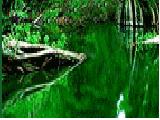Lake
Titikaka,
located 70 km west
of the city of La
Paz, covers an
area of 8 300 km².
It is fed by
meltwaters from
the glaciers in
the Apolobamba and
Royal or La Paz
Cordilleras. The
colossal peaks of
the Bolivian Andes
covered with
eternal snow rise
majestically near
the northern bank
of the Titikaka.
Copacabana lies in
a bay graced by
the Sanctuary of
Our Lady of
Copacabana. There
are other
important
pre-Hispanic sites
to be visited
there, as well,
such as Kusijata,
the Inca’s
Gallows and
Intikala, among
others.
The Island of the
Sun in the Greater
Lake is one of the
most interesting
sites in the area.
It houses
important
archeological
remains, such as
the Yamani
Staircase.
The Island of the
Moon, about one
hour by launch
from the Island of
the Sun, and known
also by its native
name of Koati, is
dedicated to
worship.
Access
A paved highway
takes visitors
from the city of
La Paz to the
Strait of Tiquina.
After crossing the
Strait by launch,
it is about a
4-hour drive to
the town of
Copacabana.
The Islands of the
Sun and the Moon
can be reached in
about an hour and
a half by river
transportation.
Tourist agencies
offer tours of the
area.
Tourist
Attractions
Lake
Exceptional
highland
landscape. It is
known for having
islands that
contain
archeological
remains in a
living testimony
handed down from
pre-Colombian
civilizations. The
Lake’s entire
coastline
interconnects with
natural areas
filled with
cattails where an
assortment of
ducks and birds
nest.
Copacabana
This town is the
repository of
major historical
remains,
particularly the
Inca’s Gallows,
the Kusijata and
the Intikala.
Sampaya
The architecture
of this
pre-Colombian town
is impressive. The
structures are
built of stone
united by mortar
and mud and roofed
with straw.
Suriki
This is the cradle
of the great
builders of the
totora, or
cattail, rafts,
using unique
techniques.
Textiles,
handicrafts and
archeological
remains can be
seen there, as
well as natural
sites.
Island of the Sun
Located in the
Greater Lake, the
island shelters
valuable
archeological
remains, the most
important of which
include the Yumani
Staircases, the
Pilcocaina Palace
and La Chincana.
Island of the Moon
This island can
only be reached by
vessel. The second
most important
sacred site of
Andean culture,
the Island of the
Moon was the
center for the
maidens of the
Sun, the chosen
place for the
worship of Women.
The architecture
of the Iñak Uyu
temple is worthy
of note. |

![]() World
News World
Top Stories Web
Search Web
Images
Search Web
Groups Search Web
Catalogs Web
Directory
News Search
World
News World
Top Stories Web
Search Web
Images
Search Web
Groups Search Web
Catalogs Web
Directory
News Search






